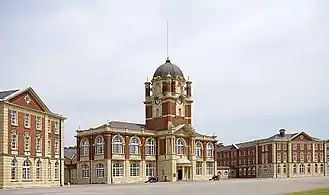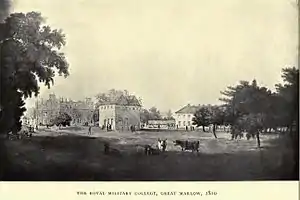Royal Military College, Sandhurst
The Royal Military College (RMC), founded in 1801 and established in 1802 at Great Marlow and High Wycombe in Buckinghamshire, England, but moved in October 1812 to Sandhurst, Berkshire, was a British Army military academy for training infantry and cavalry officers of the British and Indian Armies.
| Royal Military College, Sandhurst | |
|---|---|
 New College Buildings at Sandhurst | |
| Active | 1801–1939/1947 |
| Country | |
| Branch | |
| Role | Officer training |
| Garrison/HQ | Sandhurst, Berkshire |
| Commanders | |
| Governors, Commandants | List of Governors and Commandants of Sandhurst |
The RMC was reorganised at the outbreak of the Second World War, but some of its units remained operational at Sandhurst and Aldershot. In 1947, the Royal Military College was merged with the Royal Military Academy, Woolwich, to form the present-day all-purpose Royal Military Academy Sandhurst.
History



The Royal Military College was conceived by Colonel John Le Marchant, whose scheme for establishing schools for the military instruction of officers at High Wycombe and Great Marlow first met strong resistance on the grounds of cost.[1]
There were already some small private military academies for aspiring infantry and cavalry officers in existence, notably one which had been operated at Chelsea by Lewis Lochée from about 1770 until he wound it up in 1790. But none of them had any formal approval by the British government.[2]
In 1799, Le Marchant established a school for staff officers at High Wycombe.[3] In 1801, Parliament voted a grant of £30,000 for his more ambitious proposals,[1] and in 1801 the school for staff officers at High Wycombe became the Senior Department of the new Military College.[3] In 1802, having been appointed as the first Lieutenant Governor of the College, Le Marchant opened its Junior Department at a large house called Remnantz in West Street, Great Marlow,[4][5] to train gentleman cadets for the infantry and cavalry regiments of the British Army and for the presidency armies of British India.[6][3] 1802 was the same year as the founding of the French Army's Saint-Cyr[7] and of West Point in the United States.[8] General Sir William Harcourt was appointed as the first Governor of the Royal Military College at Great Marlow[9] and continued in post until 1811.[10] In 1812, the College's Junior Department moved from Great Marlow into purpose-built buildings at Sandhurst designed by James Wyatt,[11] and was soon joined there by the Senior Department, migrating from High Wycombe. In 1858 this became a separate institution, the Staff College.[3]
On the outbreak of the Second World War, many of the cadets and staff of the Royal Military College were mobilised for active service, but the buildings at Sandhurst remained the home of the RMC's 161 Infantry Officer Cadet Training Unit. In 1942, this unit moved to Mons Barracks, Aldershot, and for the rest of the war the Sandhurst campus was used as a Royal Armoured Corps Officer Cadet Training Unit.[12]
In 1947, a new Royal Military Academy Sandhurst was formed on the site of the Royal Military College, merging the Royal Military Academy, Woolwich (which had trained officers for the Royal Artillery and Royal Engineers from 1741 to 1939) and the Royal Military College (1802 to 1942), with the objective of providing officer training for all arms and services.[13]
Governors and Commandants
The Royal Military College was originally led by a Governor, who was a figurehead, often non-resident, a Lieutenant Governor, who had actual day-to-day command of the college, and a Commandant, who was the officer in charge of the cadets. In 1812, the posts of Lieutenant Governor and Commandant were merged into the role of Commandant. In 1888 the two remaining senior posts, Governor and Commandant, were merged into the single appointment of Governor and Commandant, which in 1902 was retitled as "Commandant".[14]
Notable cadets
- See also the much larger Category:Graduates of the Royal Military College, Sandhurst
The most notable cadets of RMC Sandhurst include:
- Sir William Denison (1825–1826), Governor of New South Wales[15]
- Field Marshal Prince Edward of Saxe-Weimar (1840–1841)
- Field Marshal Frederick Roberts, 1st Earl Roberts (1850–1851)[16]
- Frederick Stanley, 16th Earl of Derby (1861–1862), Governor General of Canada
- King Alfonso XII of Spain (1876)[17]
- Field Marshal Herbert Plumer, 1st Viscount Plumer (1875–1876)
- John Hope, 1st Marquess of Linlithgow (1878–1879), Governor-General of Australia
- Ronald Munro Ferguson, 1st Viscount Novar (1879–1880), Governor-General of Australia
- Field Marshal Viscount Allenby (1881–1882)[18]
- Sir Charles Fergusson, 7th Baronet (1882–1883), Governor-General of New Zealand
- Field Marshal Earl Haig (1884–1885)[19]
- Sir Winston Churchill (1894)[20]
- Prince Alexander of Teck (1894), later the Earl of Athlone, Governor-General of the Union of South Africa and Governor General of Canada[21]
- Field Marshal Earl Wavell (1900–1901), Viceroy of India[22]
- Field Marshal Viscount Montgomery of Alamein (1907–1908)[23]
- Sir Oswald Mosley (1914)[24]
- Field Marshal Kodandera Madappa Cariappa (1918-1919), First native-Indian full General of the Indian Army[25]
- Field Marshal Prince Henry, Duke of Gloucester (1919), Governor General of Australia[26]
- Field Marshal Ayub Khan (1926–1927), President of Pakistan[27]
- Ian Fleming (1927), author, creator of James Bond[28]
- David Niven (1930), actor, novelist [29]
References
- Major-General John Gaspard Le Marchant (1766–1812) Archived 2012-03-23 at the Wayback Machine at da.mod.uk/colleges (Defence Academy web site)
- J. E. O. Screen, “The 'Royal Military Academy' of Lewis Lochée“ in Journal of the Society for Army Historical Research Vol. 70, No. 283 (Autumn 1992), pp. 143-156
- Sovereign's Parade Programme (RMA Sandhurst, April 2012)
- R. H. Thoumine, Scientific Soldier, a Life of General Le Marchant, 1766–1812 (Oxford University Press, 1968), pp. 61–79
- Marlow Tour at marlowsociety.org.uk (Marlow Society web site)
- RMAS: The story of Sandhurst Archived 2012-05-05 at the Wayback Machine at army.mod.uk, accessed 6 July 2009
- Ecoles de Saint-Cyr at st-cyr.terre.defense.gouv.fr, accessed 6 July 2009
- Stephen Ambrose, Duty, Honor, Country: A History of West Point (Baltimore: Johns Hopkins University Press, 1966, ISBN 0-8018-6293-0), p. 22
- "No. 15377". The London Gazette. 20 June 1801. p. 691.
- Visitation of England and Wales, volume 12,p. 29, accessed 2011-07-20; archived 2012-03-30 at archive.org
- Sandhurst – Royal Berkshire History at berkshirehistory.com
- Training Archived 2012-05-05 at the Wayback Machine at army.mod.uk
- Facilities in Sandhurst – 1937
- Conference Room Archived 2011-03-14 at the Wayback Machine at sandhurstcollection.org.uk (Sandhurst Collection web site)
- C. H. Currey, “Denison, Sir William Thomas (1804–1871)”, in Australian Dictionary of Biography, archived 18 February 2011
- Robson, Brian (2008). "Roberts, Frederick Sleigh, first Earl Roberts (1832–1914)". Oxford Dictionary of National Biography. Oxford University Press. doi:10.1093/ref:odnb/35768. Retrieved 25 February 2009.
- 'Death of the King of Spain' in The Times, 26 November 1885, p. 7
- "No. 25105". The London Gazette. 9 May 1882. p. 2157.
- Gerard De Groot, Douglas Haig 1861–1928 (Unwin Hyman, 1988, ISBN 978-0044401926), p. 29
- Roy Jenkins, Churchill: a Biography (2001, ISBN 978-0-374-12354-3), p. 20
- G. E. Cokayne et. al., The Complete Peerage of England, Scotland, Ireland, Great Britain and the United Kingdom, Extant, Extinct or Dormant, vol. XIII (Gloucester: Alan Sutton Publishing, 2000) p. 258
- "No. 27311". The London Gazette. 7 May 1901. p. 3130.
- Tony Heathcote, The British Field Marshals 1736–1997 (Barnsley: Pen & Sword, 1999, ISBN 0-85052-696-5), p. 213
- Robert Skidelsky, Oswald Mosley (Holt, Rinehart and Winston, 1975, ISBN 9780030865800)
- "General K.M Cariappa Biography – General K.M Cariappa Profile, Childhood, Life, Timeline". I Love India. Retrieved 13 August 2016.
- 'Prince Henry, Duke of Gloucester' in Oxford Dictionary of National Biography (Oxford University Press, 2007)
- Karl J. Newman, Pakistan unter Ayub Khan, Bhutto und Zia-ul-Haq (ISBN 3-8039-0327-0), p. 21
- Ben Macintyre, For Your Eyes Only (London: Bloomsbury Publishing, 2008, ISBN 978-0-7475-9527-4), p. 33
- Pace, Eric (30 July 1983). "David Niven Dead at 73". Obituary. The New York Times. Retrieved 11 July 2018.
| Wikimedia Commons has media related to Royal Military College, Sandhurst. |